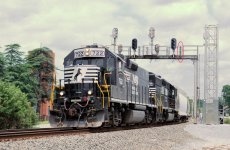I met a group of guys on a local FB page group (CnyPhotogeeks) and we got together Saturday to shoot trains. One of the guys picked up a scanner, it was beneficial to hear the train/dispatcher chatter. We were able to hear trains being dispatched and the conversations. One train that past dubbed us the "train Paparazzi" and called in our location. That was our cue to move on, I think it may have saved us all a ticket!
This is the one he picked up, it is programmed for the different frequencies so you don't have to do much and it works great,
Amazon.com : Uniden Handheld Scanner - Black (BC75XLT) : Radio Scanners : Electronics
This is the one he picked up, it is programmed for the different frequencies so you don't have to do much and it works great,
Amazon.com : Uniden Handheld Scanner - Black (BC75XLT) : Radio Scanners : Electronics

